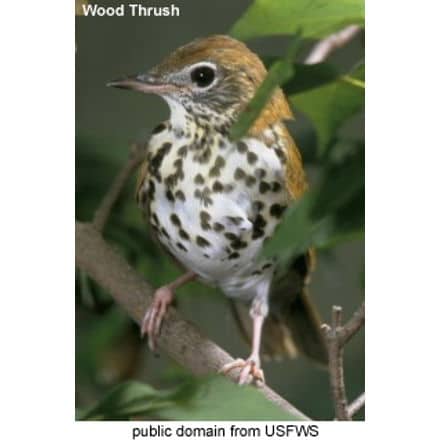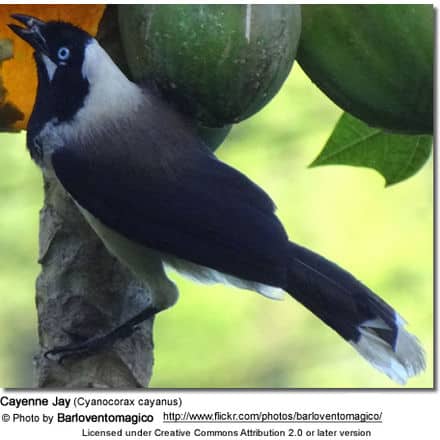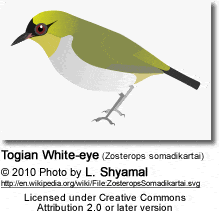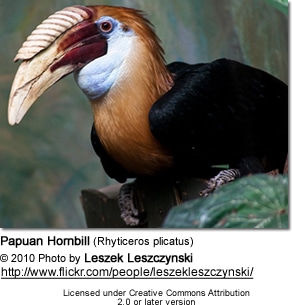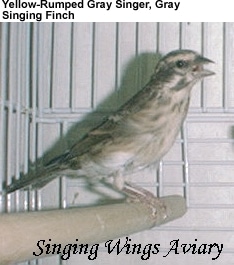Wood Thrush, Hylocichla mustelina
Thrushes
The Wood Thrush, Hylocichla mustelina, is a North American passerine bird, the only member of the genus Hylocichla. It is widely distributed across North America, wintering in Mexico and Central America. It is closely related to the typical American thrushes of the genus Catharus. It is sometimes merged into Catharus and was considered close to the long-distance migrant species of that genus, as opposed to the generally resident nightingale-thrushes, but this has been shown to be erroneous. The Wood Thrush is the official bird of the District of Columbia.
Male and female Wood Thrushes are similar in appearance. Both exhibit brown upper parts with mottled brown and white underparts. It is a medium-sized thrush. The Wood Thrush is an omnivore, and feeds preferentially on soil invertebrates and larvae, but will also eat fruits. In the summer, it feeds on insects continuously in order to meet daily metabolic needs. They are solitary, but sometimes form mixed-species flocks. Wood Thrushes defend territories that range in size from 800 to 28000 square meters. The Wood Thrush is monogamous, and their breeding season begins in the spring, and about 50 percent of all mated pairs are able to raise two broods, ranging in size from 2 to 4.
Description
Adult Wood Thrushes are 19-21 cm long, and weigh 40-50 g. The longest known lifespan for a wood thrush in the wild is 8 years, 11 months. The crown, nape, and upper back are cinnamon-brown, while the back wings, and tail are a slightly duller brown. The breast and belly are white with large dark brown spots on the breast, sides, and flanks. They have white eye rings and pink legs. Juveniles look similar to adults, but have additional spots on the back, neck, and wing coverts. Males and females are similar in size and plumage.
Distribution and habitat
The Wood Thrush’s breeding range extends from southern Canada to northern Florida and from the Atlantic coast to the Missouri River and the eastern Great Plains. Wood thrushes migrate to southern Mexico and Central America in the winter, mostly in the lowlands along the Atlantic and Pacific coasts. They generally arrive on the U. S. Gulf Coast during the first week of April. Fall migration usually begins in mid-August and continues through mid-September. Wood Thrushes migrate at night.
This bird breeds mainly in deciduous and mixed forests. It prefers late-successional, upland mesic forests with a moderately-dense shrub layer. Bertin (1977) found that these thrushes favor areas with running water, mois ground, and high understory cover. Wood Thrush breeding habitats generally include trees taller than 16 m, a fairly open forest floor, moist soil, and leaf litter, with substrate moisture more important than either canopy cover or access to running water. Wood Thrushes can breed in habitat patches as small as 1 acre, but they run the risk of higher predation and nest parasitism. The Wood Thrush’s breeding range has expanded northward, displacing the Veery and Hermit Thrush in some locations. In recent times, as a result of fragmentation of forests, it has been increasingly exposed to nest parasitism by Brown-headed Cowbirds, as well as loss of habitat in the winter range.
Behavior
Wood Thrushes are primarily solitary, but occasionally form mixed-species flocks in the winter. Their breeding territories range from 800 to 28000 square meters in size, and are used for nesting, gathering nest materials, and foraging. Some wood thrushes also defend a feeding territory in the winter. Territorial interactions are usually settled without physical contact, but in high-intensity encounters or nest defense, physical interractions with the feet or bill have been observed. Defense behaviors in response to nest predators include wing flicks, tail 
Diet
Omivorous, soil invertebrates and larvae make up most of the wood thrush’s diet, but it will also eat fruits in the late summer, fall, and late winter. They occasionally feed on arboreal insects, snails, and small salamanders. After breeding and before migration, Wood Thrushes will switch from insects to fruits with high lipid levels. In the summer, low fruit consumption and lipid reserves require the birds to feed on insects continuously in order to meet their metabolic needs.
Wood Thrushes forage mainly on the forest floor, flipping leaves over with their bills to reveal insects. They can be observed hopping around in leaf litter and on semi-bare ground under the forest canopy. Fruits are swallowed whole.
Predation
Eggs and chicks are vulnerable to chipmunks, raccoons, Blue Jays, American Crows, black rat snakes, Brown-headed Cowbirds, Common Grackles, southern flying squirrels, gray squirrels, least weasels, white-footed mice, domestic cats, Great Horned Owls, and Sharp-shinned Hawks. Adults are taken primarily taken by hawks and owls.
Reproduction
Wood Thrushes are monogamous. Breeding pairs form in mid-April to early-May, and usually last throughout the breeding season. Most thrushes find a new mate each year, and mate guarding and extra-pair copulations have not been observed in this species.
Some male Wood Thrushes arrive at the breeding grounds several days before the earliest females while other males arrive at the same time as the females, establishing territories ranging in size from one-fifth of an acre to two acres. Males begin to sing at dawn and dusk a few days after arriving at breeding grounds. Early in the breeding season, males sing from high perches in the tallest trees, but as the season progresses, they sing from lower perches and sing songs that are somewhat shorter and less elaborate. Each day’s singing begins and is most intense just before sunrise. Males may sing throughout the day but especially at dusk. The season of song is usually over by the end of July, and behaviors such as circular flights led by the female interspersed with perching together are characteristic of wood thrush pair formation and/or pre-copulatory behaviors.
Typically, the female chooses the nest site and builds the nest. Nest sites are generally in dense patches of vegetation that provied concealment and shade. Nests are located in trees or shrubs, and is usually made of dead grasses, stems, and leaves, and lined with mud, and our usually built in a fork at a horizontal branch. Nests are not reused. Usually, two broods are attempted, although three to four separate nests may be built before a pair succeeds. 2 to 4 eggs pale blue eggs are laid, at the rate of one per day. Eggs are incubated for 11 to 14 days, with the average being 13 days, by the female only. Chicks are altricial at hatching, and are mostly naked with closed eyes. The female broods the chicks during the first four days after hatching. Both parents feed nestlings and remove fecal sacs from the nest. Chicks fledge 12 to 15 days after hatching. Parents continue to feed them until they become independent and leave the parents’ territory at 21 to 31 days old. Chicks are able to begin breeding the next summer. Most females lay their first eggs in mid-May, but older females may begin laying sooner. Pairs usually attempt to rear a second brood no later than late July, with the last of the young fledging around mid-August. About half of all Wood Thrush pairs successfully raise two broods.
Vocalization
While female Wood Thrushes are not known to sing, males since a unique song that is composed of three parts. The first is often inaudible unless the listener is close, and consists of two to six short low-pitched notes such as bup, bup, bup. The middle part is a loud phrase often written ee-oh-lay, and the third part is a ventriloquial, trill-like phrase of non-harmonic pairs of notes given rapidly and simultaneously. They are able to sing two notes at once, which gives their songs an ethereal, flute-like quality. Each individual bird has its own repertoire of songs based on combinations of variations of the three parts. Songs are often repeated in order. The bup, bup, bup phrase is also sometimes used as a call, which is louder and at a greater frequency when the bird is agitated. Wood Thrushes also use or tut, tut to signal agitation.
Copyright: Wikipedia. This article is licensed under the GNU Free Documentation License. It uses material from Wikipedia.org … Additional information and photos added by Avianweb.
Please Note: The articles or images on this page are the sole property of the authors or photographers. Please contact them directly with respect to any copyright or licensing questions. Thank you.

